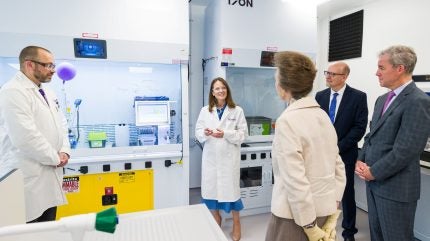
Nestled on the southern fringe of Cambridge within the Babraham Research Campus, US-based biopharma Insmed is laying the groundwork for its next chapter in rare disease therapeutics.
Known for its commercial success with lung infection therapy Arikayce, the Nasdaq-listed firm marked the mid-July opening of its innovation centre with royal fanfare from Her Royal Highness, The Princess Royal.

Discover B2B Marketing That Performs
Combine business intelligence and editorial excellence to reach engaged professionals across 36 leading media platforms.
The state-of-the art 17,000 sq ft facility forms the cornerstone of Insmed’s strategic pivot into synthetic rescue – a genetic approach focused on rewiring cellular pathways to restore function.
At the helm is Dr Tom Heightman, Senior Vice President and Head of Research at Insmed’s Cambridge site. A 25-year veteran of the pharmaceutical industry, Heightman held roles at GlaxoSmithKline, AstraZeneca, Astex and Adrestia, where he led the company’s transformation prior to its acquisition by Insmed in 2023. That platform and team now form the nucleus of Insmed’s new UK R&D hub.
“When Insmed approached us for a potential acquisition we became very interested in their science, success and culture. We saw it was a great fit between the two companies,” Heightman recalls.
“Our early-stage target discovery and drug discovery platform was well suited to Insmed, because they wanted to invest some of their clinical success in building a longer-term pipeline.”

US Tariffs are shifting - will you react or anticipate?
Don’t let policy changes catch you off guard. Stay proactive with real-time data and expert analysis.
By GlobalDataA strategic inversion of synthetic lethality
Synthetic rescue is framed as the inverse of synthetic lethality – a concept widely used in oncology.
In synthetic lethality, two concurrent gene disruptions kill the cell; by contrast, synthetic rescue seeks to identify secondary pathways that restore health when one essential gene is compromised. Insmed’s platform is designed to scale by coupling whole-genome CRISPR screens, high-throughput validation, and deep mining of human genetic datasets with computational drug design and chemistry.
Heightman describes the combination as their ‘secret sauce’.
“What makes this facility unique is two-fold. First, the synthetic rescue platform itself. Second, the ability to execute end‑to‑end drug discovery in one place: genetic discovery, data science, computational chemistry and wet‑lab synthesis.”
Though still modest in size with around 80 staff, Insmed has built a fully integrated discovery hub under one roof – a level of scientific breadth that’s uncommon for a company of its scale, says Heightman.
The team is focusing its synthetic rescue platform on rare genetic disorders, particularly those affecting the central nervous system (CNS) and neurodegenerative diseases.
“Synthetic rescue has broad applicability,” says Heightman. “It’s why both Adrestia and the Insmed leadership were drawn to it.”
The logic is practical: there are nearly 7,000 recognised rare diseases, many of which have no strong mechanistic understanding. That makes conventional drug discovery difficult. Instead, the Cambridge team are building assays and cell models from scratch to better understand the biology and patient impact, explains Heightman.
One advantage of synthetic rescue is it allows targeting of pathways that compensate for primary defects – even if the original mutation cannot be corrected directly. That opens therapeutic possibilities in genetic conditions previously considered untouchable.

Collaborative research model
The Cambridge facility joins Insmed’s three other research sites: San Diego, New Hampshire and New Jersey, each with distinct modality strengths.
San Diego is dedicated to gene therapy; New Hampshire spans biologics; New Jersey specialises in lipid‑formulated small molecules, and Cambridge focuses on small molecules and oligonucleotides.
“We operate as semi‑independent hubs with different focuses, but we convene every six months in a cross‑site symposium to share breakthroughs,” explains Heightman. The cross‑fertilisation effect, he adds, is evident in new projects that emerge from shared challenges identified across the network.
Longer-term, Insmed aims to invite cross-site use of capital-intensive equipment. That plan would avoid duplication while pooling advanced tools across the research hubs.
Heightman notes that the first half of 2025 brought promising breakthroughs across several early-stage projects led by the Cambridge team. The current focus is on generating preclinical data to advance those discoveries toward potential prototype medicines.
“We intend to make this scientific second half of the year very rich – more data, more clarity on molecules moving through preclinical development,” says Heightman.
Beyond intra-company collaboration, Insmed is also fostering a collaborative dialogue between researchers and clinicians. “We’re starting to see clinical teams ask us questions where someone within our research groups has the right expertise to help. So, there’s a valuable two-way exchange, rather than just one-way communication,” says Heightman.
Although artificial intelligence (AI) is increasingly discussed in drug discovery circles, Heightman adopts a measured view. “It works best in areas where we have deep datasets, so now we’re seeing success in specific, well-defined problems. The hope is that future generations of AI will be able to integrate different data types more holistically, But for now, I think we still need human scientists to drive the process.”
Meanwhile, Insmed continues to support its late-stage clinical trials, including brensocatib for bronchiectasis, which is being backed through public market fundraising. In June 2025, the company priced a public offering of $750 million to fund research and commercialisation – underlining investor confidence despite past operating losses.
As Insmed deepens its presence in the UK’s life sciences sector, its focus on synthetic rescue reflects a broader shift in how genetic diseases might be approached. The science remains early, and the challenges significant, but by bringing together diverse capabilities under one roof, Insmed is positioning itself to explore these questions at scale.
Ultimately, whether synthetic rescue proves to be viable path forward will depend not only on the data it generates – but how effectively it can translate those insights into meaningful treatments.





